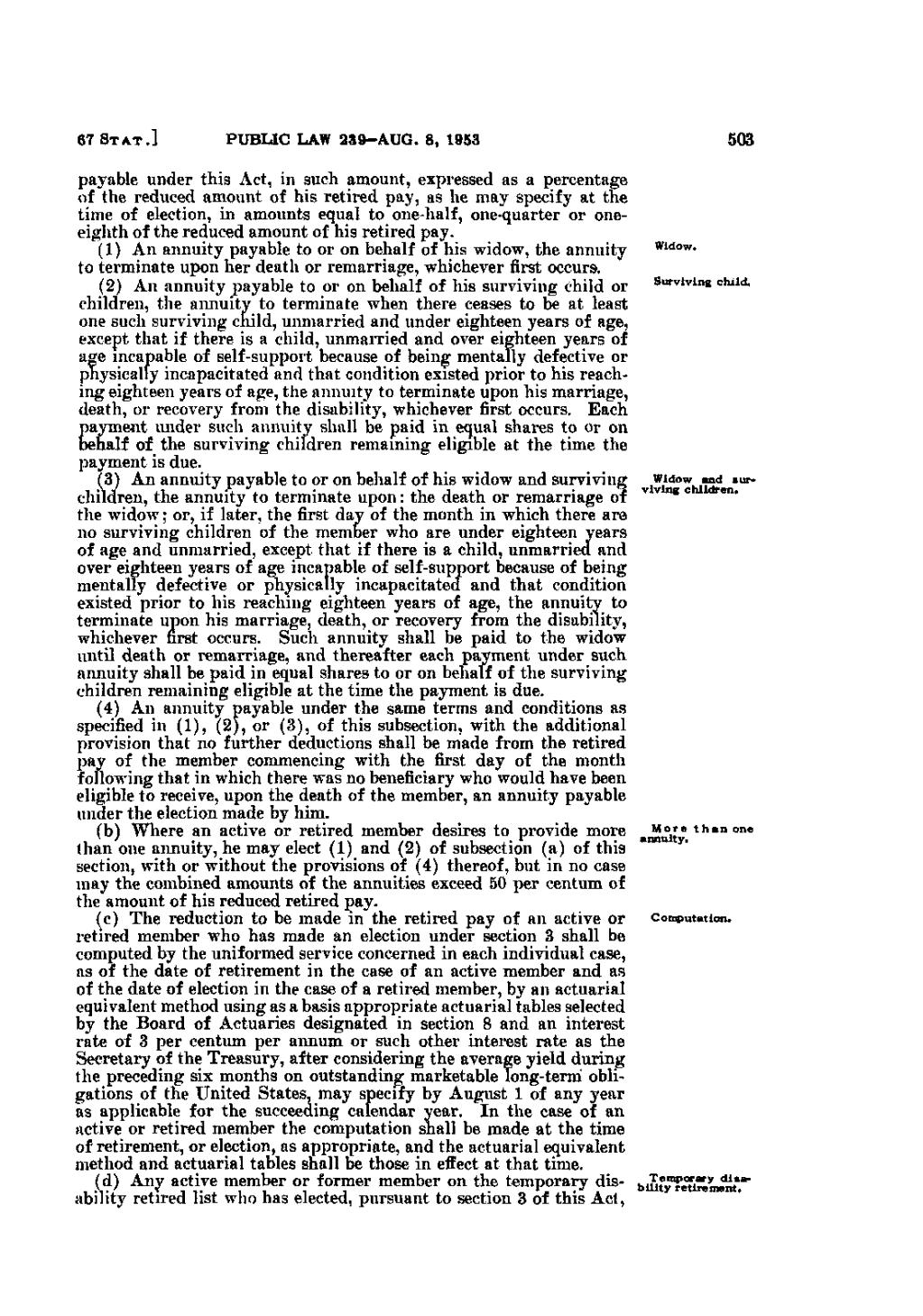67 S T A T. ]
503
PUBLIC LAW 239~AUG. 8, 1953
payable under this Act, in such amount, expressed as a percentage of the reduced amount of his retired pay, as he may specify at the time of election, in amounts equal to one-half, one-quarter or oneeighth of the reduced amount of his retired pay. (1) An annuity payable to or on behalf of his widow, the annuity to terminate upon her death or remarriage, whichever first occurs. (2) An annuity payable to or on behalf of his surviving child or children, the annuity to terminate when there ceases to be at least one such surviving child, unmarried and under eighteen years of age, except that if there is a child, unmarried and over eighteen years of age incapable of self-support because of bein^ mentally defective or physically incapacitated and that condition existed prior to his reaching eighteen years of age, the annuity to terminate upon his marriage, death, or recovery from the disability, whichever first occurs. Each payment under such annuity shall be paid in equal shares to or on behalf of the surviving children remaining eligible at the time the payment is due. (3) An annuity payable to or on behalf of his widow and surviving children, the annuity to terminate upon: the death or remarriage of the widow; or, if later, the first day of the month in which there are no surviving children of the member who are under eighteen years of age and unmarried, except that if there is a child, unmarried and over eighteen years of age incapable of self-support because of being mentally defective or physically incapacitated and that condition existed prior to his reaching eighteen years of age, the annuity to terminate upon his marriage, death, or recovery from the disability, whichever first occurs. Such annuity shall be paid to the widow until death or remarriage, and thereafter each payment under such annuity shall be paid in equal shares to or on behalf of the surviving children remaining eligible at the time the payment is due. (4) An annuity payable under the same terms and conditions as specified in (1), (2), or (3), of this subsection, with the additional provision that no further deductions shall be made from the retired pay of the member commencing with the first day of the month following that in which there was no beneficiary who would have been eligible to receive, upon the death of the member, an annuity payable under the election made by him. (b) Where an active or retired member desires to provide more than one annuity, he may elect (1) and (2) of subsection (a) of this section, with or without the provisions of (4) thereof, but in no case may the combined amounts of the annuities exceed 50 per centum of the amount of his reduced retired pay. (c) The reduction to be made in the retired pay of an active or retired member who has made an election under section 3 shall be computed by the uniformed service concerned in each individual case, as of the date of retirement in the case of an active member and as of the date of election in the case of a retired member, by an actuarial equivalent method using as a basis appropriate actuarial tables selected by the Board of Actuaries designated in section 8 and an interest rate of 3 per centum per annum or such other interest rate as the Secretary of the Treasury, after considering the average yield during the preceding six months on outstanding marketable long-terni obligations of the United States, may specify by August 1 of any year as applicable for the succeeding calendar year. I n the case of an active or retired member the computation shall be made at the time of retirement, or election, as appropriate, and the actuarial equivalent method and actuarial tables shall be those in effect at that time. (d) Any active member or former member on the temporary disability retired list who has elected, pursuant to section 3 of this Act,
Widow. Surviving child.
Widow and surviving chilcfren.
More than one annuity.
Coiiq>utation.
Temporary disability retirement.
�
